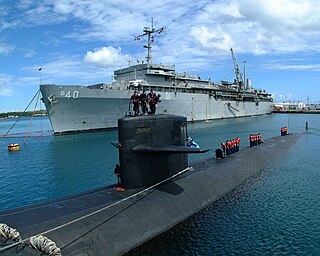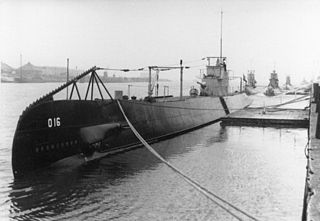
HNLMS Abraham Crijnssen is a Jan van Amstel-class minesweeper of the Royal Netherlands Navy (RNN).
The Royal Netherlands Navy is the maritime service branch of the Netherlands Armed Forces. It was founded on 8 January 1488, making it the third-oldest naval force in the world.

A submarine tender, in British English a submarine depot ship, is a type of depot ship that supplies and supports submarines.
The Royal Netherlands Navy Mine Service is a department within the Royal Netherlands Navy that is responsible for keeping Dutch coastal waterways and approaches to major seaport areas mine-free. It was established out of the Royal Netherlands Navy Torpedo Service in 1907.

SM UC-8 was a German Type UC I minelayer submarine or U-boat in the German Imperial Navy during World War I. The U-boat had been ordered by November 1914 and was launched on 6 July 1915. She was commissioned into the German Imperial Navy on 5 July 1915 as SM UC-8. Mines laid by UC-8 in her one patrol are not known to have sunk any ships. UC-8 ran aground on the Dutch coast near Terschelling on 4 November 1915. Interned by the Dutch, UC-8 was purchased and commissioned into the Dutch Navy as HNLMS M 1. The submarine was broken up in 1932.

HNLMS O 16 was a submarine of the Royal Netherlands Navy that saw service during World War II. She was the first submarine of the RNN manufactured from high-quality Steel 52, with the ability to dive at a depth of 80 metres (260 ft).

HNLMS Mercuur (A900) is a submarine support ship of the Royal Netherlands Navy. The ship was built and designed specially to support the Dutch submarines. She entered service on 21 August 1987, and is the only surface vessel attached to the Dutch submarine service.

HNLMS Noord-Brabant (D810) was a Holland-class anti-submarine destroyer of the Royal Netherlands Navy. The ship was from 1955 to 1974 in Dutch service. On 9 January 1974, HNLMS Noord-Brabant was rammed amidships by an English merchant ship. The damage was estimated to be expensive so the Royal Netherlands Navy decided to not repair the damage but instead decommission the ship earlier than planned. The ship's radio call sign was "PAIP".

The Buyskes class was a class of two hydrographic survey vessels that were part of the Dutch Hydrographic Service of the Royal Netherlands Navy. Together with HNLMS Tydeman the ships of this class were the main ships of the Dutch Hydrographic Service during the last quarter of the 20th century. While the ships of the Buyskes class were built for performing hydrographic research, the Tydeman was focused on oceanography.

The Van Straelen class was a ship class of sixteen minesweepers that were built in the Netherlands for the Royal Netherlands Navy (RNN). They were taken into service of the RNN between 1960 and 1962 and served until 1 March 1983.
The Beemster-class was a class of fourteen minesweepers that were built at different shipyards in the United States for the Royal Netherlands Navy (RNN). The minesweepers were based on the AMS-60 design and paid for by the United States under the Mutual Defense Assistance Program (MDAP). The minesweepers served in the RNN between 1953 and 1976.

The Dokkum class was a ship class of eighteen minesweepers that were built in the Netherlands for the Royal Netherlands Navy. They were paid for by the United States under the Mutual Defense Assistance Program (MDAP).

The Onversaagd class was a ship class of six minesweepers that were built in the United States for the Royal Netherlands Navy (RNN). They were paid for by the United States under the Mutual Defense Assistance Program (MDAP). The minesweepers were based on the design of the Aggressive class and taken into service of the RNN between 1954 and 1955.

HNLMS Scheveningen (M841) is the fourth ship in the City / Vlissingen-class mine countermeasures vessels, and second to be built for the Royal Netherlands Navy.

HNLMS Krakatau was a minelayer of the Royal Netherlands Navy (RNN). She was built in the Dutch East Indies and served between 1924 and 1942 in the RNN.

HNLMS Rigel was a multi-purpose steamship of the Government Navy that could also be used as minelayer and as yacht for the Governor-general of the Dutch East Indies. The ship was militarized in 1939 and taken into service of the Royal Netherlands Navy, where it served as minelayer between 1939 and 1942.
HNLMS Nautilus (M12) was a minelayer and patrol vessel of the Royal Netherlands Navy (RNN). She was built in the Netherlands and served in the RNN between 1930 and 1941.

HNLMS Jan van Brakel was a minelayer and patrol vessel of the Royal Netherlands Navy (RNN). She was built in the Netherlands and served in the RNN between 1936 and 1957.
HNLMS Scheveningen may refer to the following ships of the Royal Netherlands Navy that have been named after Scheveningen:

Elizabeth Smit was a ship built in 1941, and scrapped in 2020. It was built for the Royal Navy as the MMS-class minesweeper HMS MMS 54. It was transferred to the Royal Netherlands Navy in 1944, serving as HNLMS Marken. In 1957, it became a school ship for the Dutch Zeekadetenkorps. It was sold in 1977 and turned into a barquentine in civilian service, renamed Elizabeth Smit. It was badly damaged in 2002 and was scrapped in 2020.















